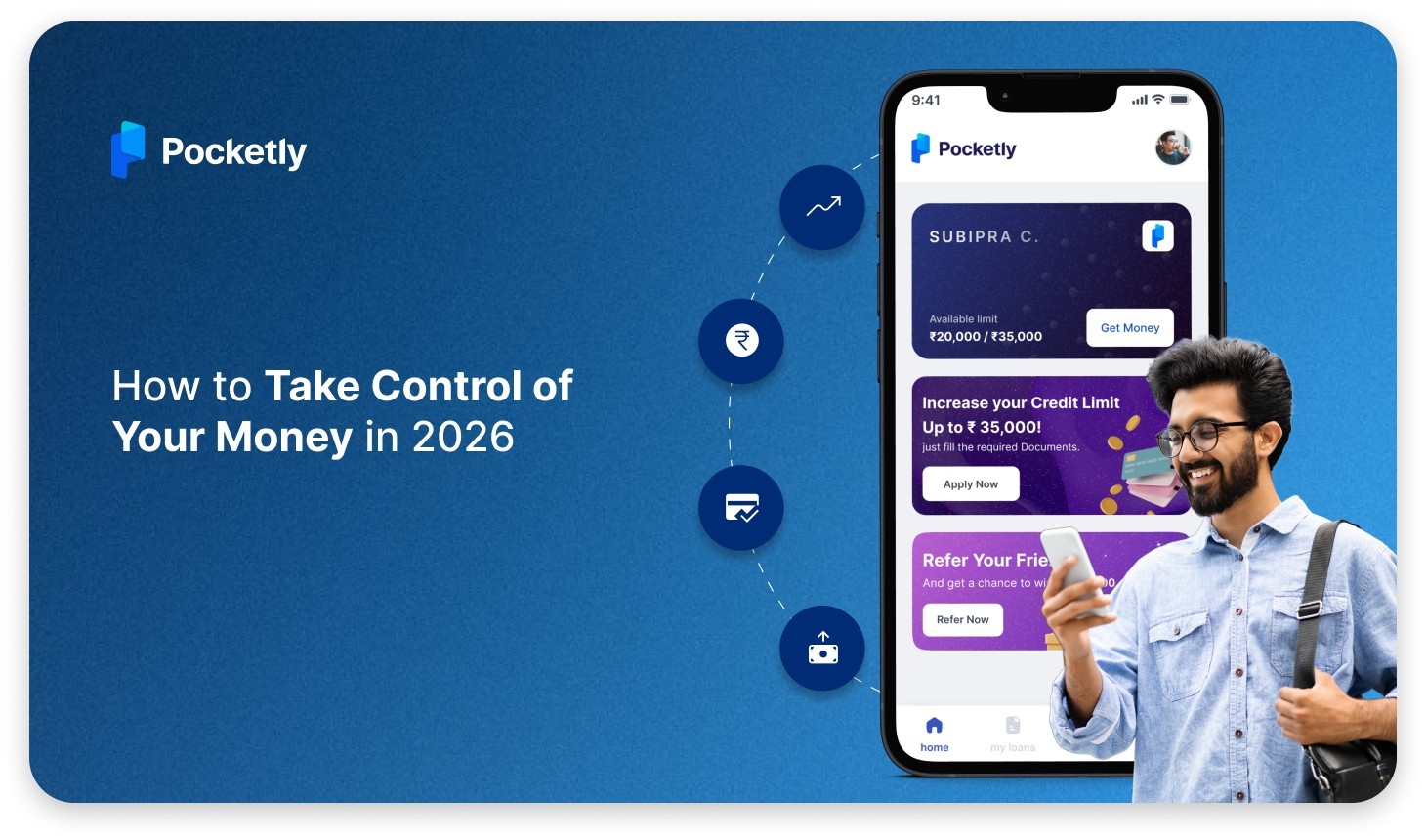
Have you ever missed an EMI payment on your personal loan? It might seem like a small mistake, but the consequences can have a bigger impact than you think. From penalties to a drop in your credit score and even legal action, a bounced EMI can create a ripple effect on your financial health.
Life can throw unexpected challenges at you; sometimes, it’s easy to miss a payment. However, failing to keep up with your EMIs can result in more than just a temporary inconvenience; it can affect your ability to borrow in the future and put a strain on your finances.
In this blog, we'll walk you through the consequences of an EMI bounce, explain how it can impact your credit score, and provide practical advice on how to avoid or resolve the situation.
What is an EMI Bounce?
An EMI bounce happens when a scheduled repayment for a loan fails due to insufficient funds in your bank account. It’s a common term in the world of personal loans and refers specifically to when the lender is unable to process the loan repayment on the due date.
How Does It Happen?
- Insufficient Funds: If the borrower’s bank account doesn’t have enough balance to cover the EMI.
- Technical Issues: Bank errors or technical glitches may occasionally cause an EMI bounce.
- Missed Payment: Sometimes, borrowers forget to ensure there are sufficient funds available, especially if the loan payment date is close to other expenses.
The impact of an EMI bounce is more than just a missed payment. When this happens, the borrower usually has to pay a penalty fee, and the failure to pay can trigger additional charges or interest on the loan. This can make a simple oversight quite costly over time.
Now that we understand what an EMI bounce is and how it occurs, let's look at the immediate consequences it brings with it, which can affect your finances in several ways.
Immediate Consequences of EMI Bounce
Once an EMI bounce occurs, the immediate effects can be far-reaching. It’s not just about missing a payment; it triggers a series of financial consequences that can have an impact on your credit score, your loan terms, and your future borrowing ability. Let’s explore the immediate consequences of an EMI bounce:
1. Late Fees and Penalties
The first consequence of an EMI bounce is the late fees or penalties imposed by the lender. These charges can vary depending on the lender’s policy and the terms of your loan agreement, but they can significantly add to the overall cost of your loan.
Example: A penalty fee of 1-2% of the bounced EMI amount may be levied, adding an extra financial burden.
2. Increased Loan Tenure
If you miss an EMI, the lender may extend your loan tenure, which results in you paying more over time. The extended period means additional interest will accumulate, making the loan more expensive in the long run.
Example: If your EMI is ₹5,000 and your loan term is extended by 6 months, you may end up paying an additional ₹30,000 in interest.
3. Higher EMI Amounts
In some cases, lenders may adjust the EMI to reflect the delay. This could mean higher monthly payments, especially if you have multiple bounced payments. This not only affects your monthly budget but also places additional pressure on your finances.
But the consequences don’t end there. One of the most significant effects of an EMI bounce is its impact on your credit score. A single missed payment can harm your creditworthiness, making it harder for you to secure loans in the future. Let’s take a closer look at how a bounced EMI influences your credit score.
Also Read: Impact of Personal Loan Cancellation on Your Credit Score
Impact of EMI Bounce on Your Credit Score
An EMI bounce does more than just impact your immediate finances. It also leaves a lasting mark on your credit score, which is a crucial factor in determining your eligibility for future loans, credit cards, and even insurance premiums. Here’s a detailed look at how a missed EMI payment can affect your credit score:
1. Recording of Payment Defaults on Your Credit Report
When an EMI payment bounces, it gets recorded by the credit bureaus and becomes a part of your credit report. This event serves as a red flag to lenders, indicating that you’ve failed to meet a financial obligation. Even a single missed payment can trigger a noticeable decline in your credit score.
Impact: Your credit score could drop by anywhere from 20 to 50 points, depending on how severe the issue is and the number of payments missed. This drop could have long-lasting effects on your borrowing ability.
2. The Long-Term Consequences of Multiple Bounces
Repeated EMI bounces paint a picture of financial instability, and the impact compounds over time. Lenders view such patterns as high-risk behavior, making it harder for you to access new credit or loans.
Impact: Multiple missed payments could result in a significant drop in your credit score, which can stay on your report for years. This severely limits your ability to secure loans or favorable interest rates in the future.
3. A Ripple Effect on Your Financial Life
A poor credit score can affect various aspects of your financial life beyond just loan eligibility. It can influence your insurance premiums, the ability to rent property, and even the terms on which you can open new credit accounts. The ripple effect can make managing your finances more difficult in the long run.
Impact: A damaged credit score due to EMI bounces can affect your reputation as a borrower and force you to pay higher interest rates or deal with restrictions in future financial dealings.
4. The Difference Between Voluntary and Involuntary EMI Bounces
While both types of EMI bounces impact your credit score, involuntary bounces typically cause more damage than voluntary ones. Voluntary bounces often happen when the borrower decides to pay off the loan early, but can still negatively impact the score if the payment isn’t processed on time. Involuntary bounces, however, indicate financial distress and the inability to make timely payments.
Impact: Involuntary EMI bounces are more likely to raise red flags for lenders, signaling that you may be a high-risk borrower.
How to Mitigate the Impact on Your Credit Score
To recover from the impact of EMI bounces and protect your credit score, it’s essential to focus on responsible borrowing behavior:
- Pay your dues promptly to prevent further missed payments.
- Avoid multiple loan applications to limit credit inquiries.
- Regularly monitor your credit report to dispute any inaccuracies and ensure your score reflects your true financial behavior.
By taking these steps, you can start rebuilding your credit score over time and improve your financial standing.
While the impact on your credit score is significant, the legal consequences of an EMI bounce can be even more severe. Lenders may take immediate action to recover the owed amount, and this can affect your financial reputation for years to come. Let’s explore what you could face legally if your EMI payment bounces.
If you're new at calculating your EMIs and want to learn in detail, check out our guide on Calculating Personal Loan EMI Using Excel Method.
Legal Consequences of EMI Bounce
A missed EMI doesn’t just hurt your credit score; it can also lead to legal action from the lender. Lenders have the right to pursue legal measures to recover the owed amount if your loan continues to go unpaid.
Actionable Measures by Lenders
When an EMI bounce occurs, lenders take various actions to recover the amount:
- Legal Notices: Banks typically issue legal notices for larger loans as a formal warning, outlining the consequences of continued non-payment. Digital lenders and NBFCs, however, tend to start with reminders and follow-ups before escalating the issue.
- Debt Recovery: For long-unpaid loans, banks may engage debt collection agencies or negotiate a repayment plan. NBFCs and digital lenders prefer flexible solutions like loan restructuring or payment moratoriums.
- Court Action: In extreme cases, banks may file lawsuits to recover the debt, which could involve freezing accounts or placing liens on property. Digital lenders and NBFCs usually avoid court action, offering alternative dispute resolutions or revised repayment terms.
Impact on Borrower’s Reputation
An EMI bounce can harm both your financial standing and reputation:
- Labelled as a Defaulter: If reported to credit bureaus or legal authorities, the borrower may be classified as a defaulter, making it harder to secure future loans. However, smaller loans typically have less severe consequences unless non-payment becomes a pattern.
- Difficulty Obtaining Future Loans: A history of unpaid EMIs, especially with banks, can lead to loan rejections or higher interest rates. Digital lenders and NBFCs, however, are more likely to work with the borrower and offer flexible repayment options.
If you're worried about missing your EMIs and facing serious legal consequences, Pocketly can offer you a quick, collateral-free loan solution without the hassle. Whether it's an urgent need or a short-term financial challenge, Pocketly makes borrowing simple, transparent, and fast. Download Pocketly today and take control of your finances without the stress of complex paperwork or collateral.
Alternatives and Solutions to Avoid EMI Bounce
An EMI bounce can create unnecessary stress, but with the right steps, you can prevent it or mitigate its impact if it happens. Whether you’re trying to avoid an EMI bounce or looking for ways to handle it once it occurs, here's a comprehensive approach to managing your EMIs effectively:
1. Set Up Automatic Payments
One of the simplest yet most effective ways to prevent an EMI bounce is by setting up automatic payments. By linking your loan account to your bank account, the required EMI will be deducted automatically on the due date, ensuring that you never miss a payment.
Why It Helps: This helps you avoid the hassle of manually remembering and processing payments each month, reducing the risk of missed payments due to forgetfulness or cash flow issues.
2. Restructure Your Loan If You Face Financial Difficulty
If you're going through a temporary financial struggle, don’t wait for the EMI to bounce. Talk to your lender and explore the option of loan restructuring. This allows you to modify the repayment schedule or reduce the EMI temporarily, so you can get back on track.
Why It Helps: It provides flexibility by adjusting the repayment terms to suit your current financial capacity, ensuring you don't fall behind due to short-term challenges.
3. Prioritize Debt Repayments
Managing multiple loans can be difficult, but prioritizing your debt repayments is crucial. Identify loans with higher interest rates or those with more severe consequences for missed payments, such as personal loans, and make them your top priority.
Why It Helps: This helps ensure that you stay on top of your financial obligations, preventing a cascade of missed payments across multiple loans.
4. Act Quickly If an EMI Bounce Happens
Sometimes, despite our best efforts, an EMI might bounce. When this happens, quick action is key. Here’s what you can do immediately:
- Contact the Lender: As soon as you realize an EMI bounce has occurred, get in touch with your lender. Many lenders are willing to work with you if you communicate early.
- Make the Payment Quickly: Arrange the payment for the bounced EMI as soon as possible. The sooner you make the payment, the lower the impact it will have on your credit score and your relationship with the lender.
- Why It Helps: Swift action can prevent further penalties, interest accumulation, and the risk of the lender taking more serious steps like legal action.
5. Prevent Future Bounces
While dealing with a bounced EMI is important, the key to long-term financial health is prevention. Here are a few ways to reduce the likelihood of future EMIs bouncing:
- Track Your Bank Balance: Ensure that you have enough balance to cover your EMI each month. Set reminders to review your bank account before the payment date.
- Establish an Emergency Fund: Having an emergency fund allows you to cover unexpected shortfalls and ensures your EMIs are always paid on time.
- Monitor Your Credit Usage: Keep track of your credit usage to avoid overextending yourself. Staying within your credit limits helps maintain the funds you need for loan payments.
- Why It Helps: Proactive steps like these ensure that you're not caught off guard by cash flow issues, giving you the stability to meet your financial obligations.
Managing EMI payments and avoiding bounced payments can sometimes feel overwhelming, especially during financially tight times. This is where Pocketly steps in, offering a simple, fast, and flexible loan solution without the complexities of traditional lending. Let’s explore how Pocketly can help you stay on top of your finances.
How Pocketly Can Help You Stay on Track with Your Loan Repayments
When unexpected expenses arise, managing your finances can become tricky. Traditional loans often come with rigid repayment schedules and the requirement of collateral, making them difficult to navigate when you're already in a financial crunch. But Pocketly offers a different, more flexible solution for young Indians facing such challenges.
1. No Collateral Needed
Unlike traditional loans that require you to pledge assets, Pocketly offers collateral-free loans, making the borrowing process stress-free and quick. Whether you need ₹1,000 for a small expense or up to ₹25,000 for a larger need, Pocketly helps you get funds without any security.
2. Quick and Easy Process
With a simple application process, you can apply for a loan within minutes and receive funds almost instantly. All you need is basic KYC details (Aadhaar or PAN), and there’s no long waiting period or confusing paperwork.
3. Flexible Loan Repayment
Pocketly understands that life can be unpredictable, so it offers flexible repayment options that fit your budget. Whether you need to break up the payments into small EMIs or pay off the loan early without penalties, Pocketly adapts to your financial situation.
4. Transparent Terms
One of the biggest concerns with traditional loans is hidden fees or unexpected costs. Pocketly ensures complete transparency with clear, upfront fees. Loan amounts start at just 2% interest per month, with processing fees ranging from 1-8%, so you always know exactly what you’re signing up for.
5. Quick Approval with Minimal Documentation
No need to go through endless steps to get a loan. Pocketly’s digital-first platform allows for quick approvals with minimal documentation required, making it perfect for busy students, professionals, and entrepreneurs who need fast access to funds.
6. Available for Various Needs
Whether you're a student facing tuition fees, a salaried individual needing to cover month-end expenses, or an entrepreneur with an urgent business requirement, Pocketly caters to various needs with flexibility and speed.
With Pocketly, you can get back on track financially, no matter the challenges you face. It’s designed to support you in times of need without the stress of traditional lending methods. Download the Pocketly app today to simplify your financial life and gain access to easy, quick loans.
Conclusion
Managing loan repayments and avoiding EMI bounces is critical for maintaining a healthy financial profile. While various strategies and solutions are available, taking proactive measures like setting up automatic payments and restructuring loans can help you avoid financial stress. However, if you’re facing unexpected challenges and need fast, flexible financial support, Pocketly offers a quick and convenient solution with its collateral-free loans, transparent terms, and easy application process.
By choosing Pocketly, you gain access to a loan that adapts to your circumstances, helping you manage your finances with confidence. Download Pocketly today and experience the convenience of quick, no-collateral loans at your fingertips.
For more information, feel free to contact us. Our team is ready to assist you in making smart, financially sound decisions.
FAQs
1. What happens if I miss a personal loan EMI?
If you miss a personal loan EMI, the lender may charge late fees, and your credit score may drop. Repeated missed payments can lead to legal actions and affect your ability to borrow in the future.
2. How does a bounced EMI affect my credit score?
A bounced EMI can significantly lower your credit score, especially if it’s reported to credit bureaus. A lower score means higher interest rates or difficulty in securing loans in the future.
3. Can I restructure my loan if I can’t pay the EMI?
Yes, most lenders allow for loan restructuring. You can request to modify the terms of the loan, such as extending the repayment period or lowering the EMI amount to make it more manageable.
4. How can I prevent an EMI bounce?
To prevent EMI bounces, set up automatic payments, monitor your bank balance regularly, and ensure your income matches your repayment capacity. Having an emergency fund can also provide a buffer for unexpected financial challenges.
5. What are the legal consequences of a missed EMI?
Legal consequences of missed EMIs can include legal notices, recovery procedures, and potential court action. Additionally, you may be labeled a defaulter, which can severely affect your financial reputation and loan eligibility.

















